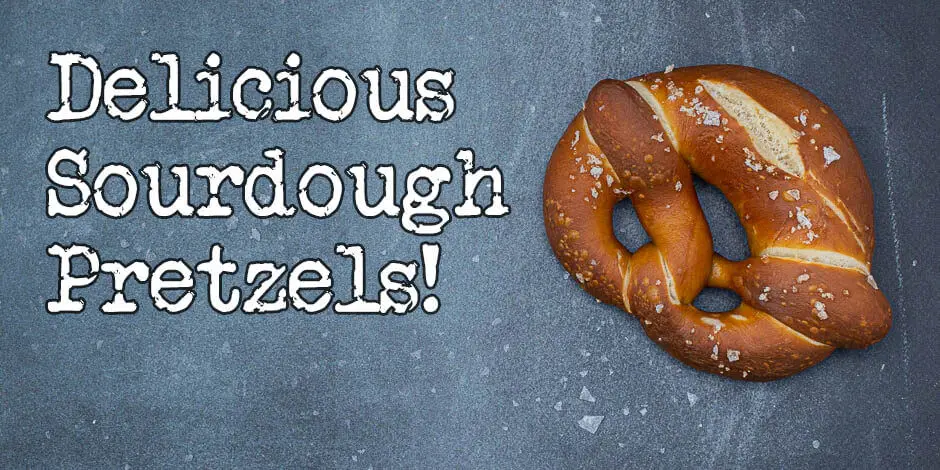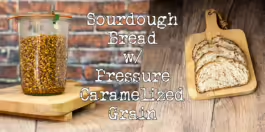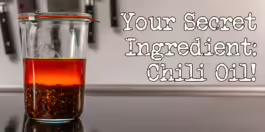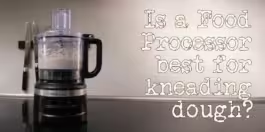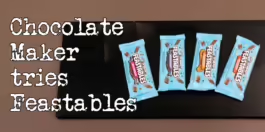Pretzels are magical. Soft on the inside, chewy and deeply caramelized crust, with that telltale tingling and slightly soapy taste. Evoking childhood memories of amusement parks, maybe Oktoberfest, or, in my case, visiting my Dad in Germany. I love an amazing pretzel, I am sure you do too. This is my recipe for sourdough pretzels.
There are soft pretzels and hard pretzels. This article and recipe are for soft pretzels that are big and soft on the inside, whereas hard pretzels are small and crunchy. While they have similar taste characteristics, the soft pretzels are Ambrosia in my opinion. It’s simply the best-baked snack that you can make.
If you are a regular reader of my blog, you will probably have noticed that I have already published recipes for both soft pretzels and pretzel buns before, but both use yeast. So the time has come for a sourdough version of this awesome snack.
If you are just here for the recipe, you can press the button underneath to be automagically transported to the recipe:
Jump to Recipe Jump to VideoThe history of pretzels
An often-told origin story of pretzels is that they were created by a monk in Italy around 610.
According to The History and Science and Technology, the monk baked strips of dough that were folded into a shape looking like a child crossing its arms in prayer. He called these baked goods pretiolas, meaning little rewards to children who remembered their prayers.
Like most other origin stories, they are probably being told because they are just that. Good stories.
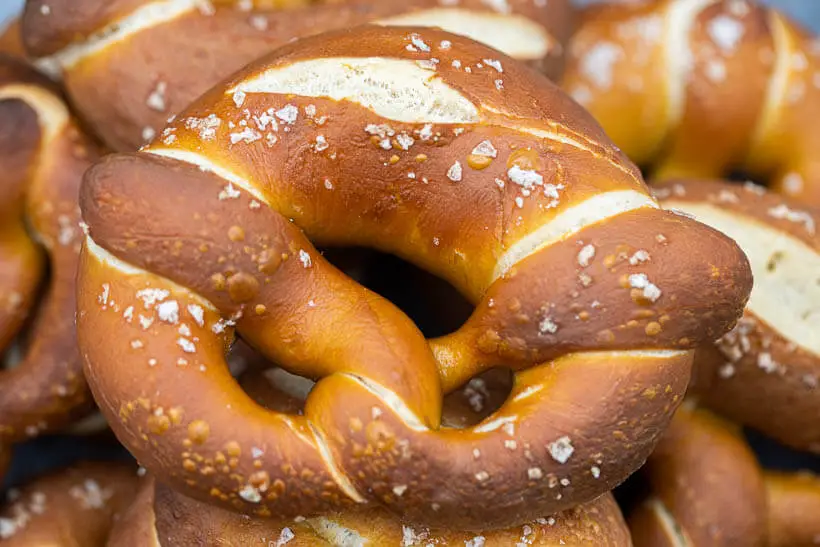
The earliest recorded evidence of pretzels comes from the logo used by the German baker’s guild in 1111.
Pretzels have been a part of the Christian faith for a long time. In Germany, in the 16th century, it became a tradition to eat pretzels on Good Friday.
These days pretzels are the most popular in Germany and the United States.
The mysterious alkaline bath
What gives the pretzels their distinctive taste and texture is a combination of a low-hydration dough and the lye bath that the pretzel is dipped in before being baked.
The lye bath
The bath is a solution of 3-4% lye to water. Lye is highly corrosive in its pure form, but at the concentration we use it here, it’s not super dangerous. If you get it on your skin, just wash it off.
That being said, still, be careful around it. I wear some heavy-duty plastic gloves and protective glasses so that I don’t get hurt. Why risk it?
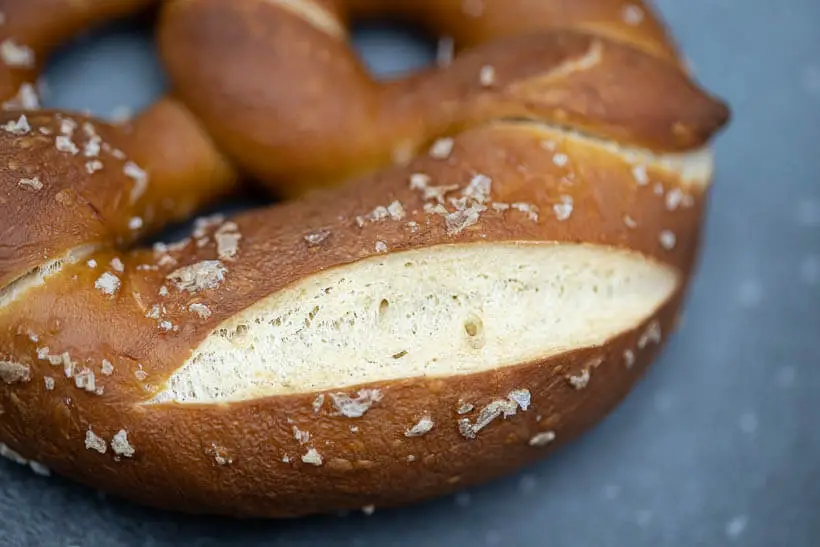
How does it work?
When anything is baked, a process called the Maillard reaction happens. It’s a chemical reaction between amino acids and small sugars that gives browned food its distinctive flavor.
Dipping the pretzels in lye solution alters the ratio between sugar and protein because lye breaks proteins present on the surface of the dough into smaller bits. Those small bits are amino acids that are then combined with the sugars to create the flavor compounds in the crust.
You can use a lot of baking soda to get an alkaline solution. It works somewhat, at least better than not using it, but it does not give you that perfect crust and taste that you want.
You can see the difference between a pretzel dipped in a lye solution (top) and a pretzel dipped in a baking soda solution (bottom). The baking soda one is definitely darker than if it hadn’t been dipped, but it’s not quite right.
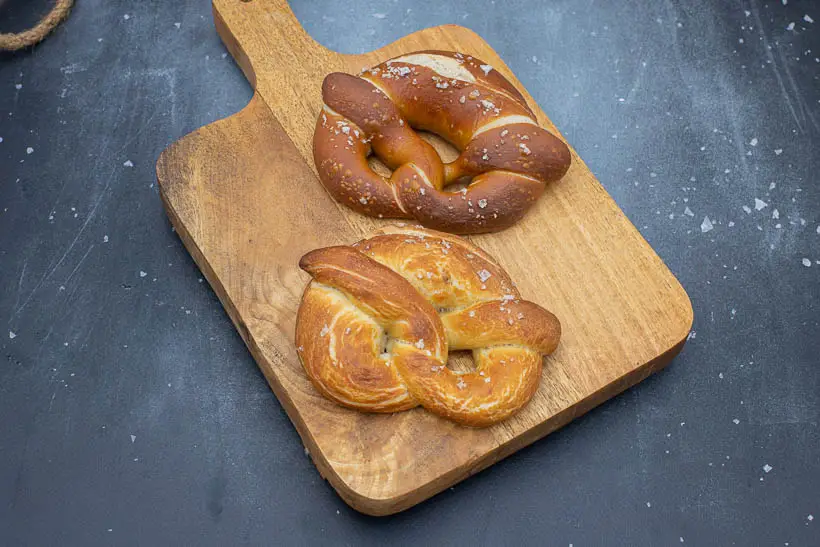
The formula of this sourdough pretzels recipe
Vitals
| Total weight | 1200 grams |
| Pre-fermented flour | 10.7% |
| Hydration | 54.4% |
| Yield | 12 x 100 grams pretzels |
Levain
The levain used in this sourdough pretzels recipe is a tool to help you use your starter at its peak. If you are in a hurry, you can swap it out for 200 grams of mature starter.
| Weight | Ingredient | Baker's Percentage |
|---|---|---|
| 66g | bread flour | 100.0% |
| 66g | water | 100.0% |
| 33g | starter (100% hydration) | 50.0% |
Dough
The dough in the pretzels is enriched dough. It doesn’t have a lot of butter, but just enough to make the crumb soft and have that wonderful butter aroma.
The hydration is really low. This is what is called dry dough. It’s important to get the right texture. This is also why the dough is kneaded instead of folded. We develop gluten the fashioned way where we agitate the dough by, quite violently, squeezing and pressing the dough down towards the table.
| Weight | Ingredient | Baker's Percentage |
|---|---|---|
| 685g | bread flour | 100.0% |
| 335g | water | 48.9% |
| 75g | butter | 10.9% |
| 15g | salt | 2.2% |
If you want to change the formula for the pretzels (maybe make more in one go?), you can do so here in my bread calculator.
The conclusion of this sourdough pretzels recipe
These pretzels are just wonderful. They tick all the boxes for a perfect pretzel for me:
- Dark and chewy crust
- Dense but soft and well-fermented crumb
- That special pretzel taste that you need

Also, if you want larger pretzels, just make fewer pretzels out of the same dough. If you just make two gigantic pretzels, that are also an option. The baking time will increase, but not a lot.
So start out with the 18-22 minutes and monitor them closely.
Get going. Start making these. They are totally awesome.
Please share this recipe for sourdough pretzels on social media
This is my recipe for sourdough pretzels. I hope you will try to make them because they are absolutely scrumptious. Please consider sharing this recipe on social media with other bakers.
If you do make them and you post them on Instagram, please tag me as @foodgeek.dk so I can see them. That will make me very happy. Thank you.
Ad links! The links for equipment and ingredients in this recipe are affiliate links, which means I will receive a commission if you purchase the product.
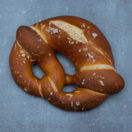
Sourdough Pretzels
Equipment
Ingredients
Levain
- 66 g bread flour
- 66 g water
- 33 g sourdough starter
Dough
- 685 g bread flour
- 335 g water
- 75 g butter
- 15 g salt
Topping
- flaky salt
Lye Bath
- 1000 g water
- 30 g sodium hydroxide
Instructions
Make levain
- Mix 33g mature sourdough starter, 66g water and 66g bread flour until it's completely mixed in a tall glass container.
- Put an elastic band around the container so you can monitor the growth. Let it grow to its peak.
Autolyse
- Put 685g bread flour in a bowl. Add 15g salt on top. Mix it with your fingers.
- Add 335g water, stick your index and middle finger in the dough and move in circles. Pick up a little more flour for each revolution until the dough comes together.
- Dump it on your kitchen counter and knead all the flour into the dough (4-5 minutes).
- Form a boule and put the dough back in the bowl. Let it rest covered until the levain has grown.
Cube butter
- About ½ hour before the levain is ready, take 75g of butter out of the fridge and cut it into cubes. Leave it to come up to temperature on the kitchen counter.
Mix dough
- When the levain has peaked, put the boule on the kitchen counter and scatter the levain on top.
- Knead it into the dough. About 5-6 minutes. Leave it to rest covered for about 30 minutes.
Knead butter into the dough
- Take the dough out of the bowl and add to your kitchen counter.
- Push it into a disk shape and add a couple of butter cubes along the edge.
- Seal all the butter in by flipping the edge over the dough.
- Then knead the dough until the butter is incorporated.
- Then repeat by making a disk and kneading in more butter until all the butter has been incorporated into the dough (6-7 minutes).
- Then form the dough into a boule, put it back in the bowl, and let it rest covered for 30 minutes.
Divide and preshape
- Divide the dough into 12 equally sized pieces, about 100g each.
- Put the dough under a wet cloth to prevent it from forming skin.
- Take each piece of dough and form a small ball this way:
- Push the dough into the center at the bottom of the ball. Turn the ball about an ⅛ and repeat until you have a reasonably taut surface.
- Then put the ball down on your counter and put your hand over the top like a claw, and move it in circles to make a perfect ball.
- Put it back under the cloth and shape the other 11 pieces of dough the same way.
- Leave them to rest for 30 minutes to relax the gluten.
Final shape
- Take one ball and roll it out to a long strand of dough, about 1 meter/3 feet 4 inches. It should be thicker in the middle.
- Lift the ends, cross them and put them down on the table, and cross the strands.
- Lift the ends, flip them down to the lower part and place the ends decoratively.
- I recommend that you watch the video on the shaping. The shaping is the hard part.
- Put six pretzels on one baking sheet, cover it with cling film and do the same with the other 6.
Final proof
- Leave to proof on the counter for about 2 hours. They should have visibly grown.
- Then move into the freezer for 30 minutes. If you don't have room in the freezer, you can use the fridge. This step is to help keep the carefully shaped pretzels intact.
- Heat your oven to 230°C/450°F using the fan assist. If you don't have fan assist go to 240°C/475°F.
The dipping and baking
- Before the 30 minutes are up, put on safety gear (gloves and glasses), add 1 liter (about 4¼ cups) of water to a non-reactive bowl, and add 30g of foodgrade lye.
- Mix it with a wooden spoon until all the lye granules have been dissolved.
- Then grab the sheets of pretzels from the freezer.
- I put two in at a time for about 30 seconds.
- Put them back on the baking sheet on the parchment paper.
- Once you've dipped them all, drizzle them with flaky salt.
- Score the pretzels in the thick part with a swift and relatively deep cut.
- Put the first pan in the oven and bake for 10 minutes. Then turn your oven down to 220°C/425°F. Rotate the pan do you get even browning.
- Bake for another 8 to 12 minutes until they are deeply caramelized and done.
- While the first tray is baking prepare the other 6 pretzels by dipping them in lye and putting them back on the sheet.
- Let all the pretzels cool on a wire rack.
- Dispose of your lye solution by pouring it into the toilet and flushing.



